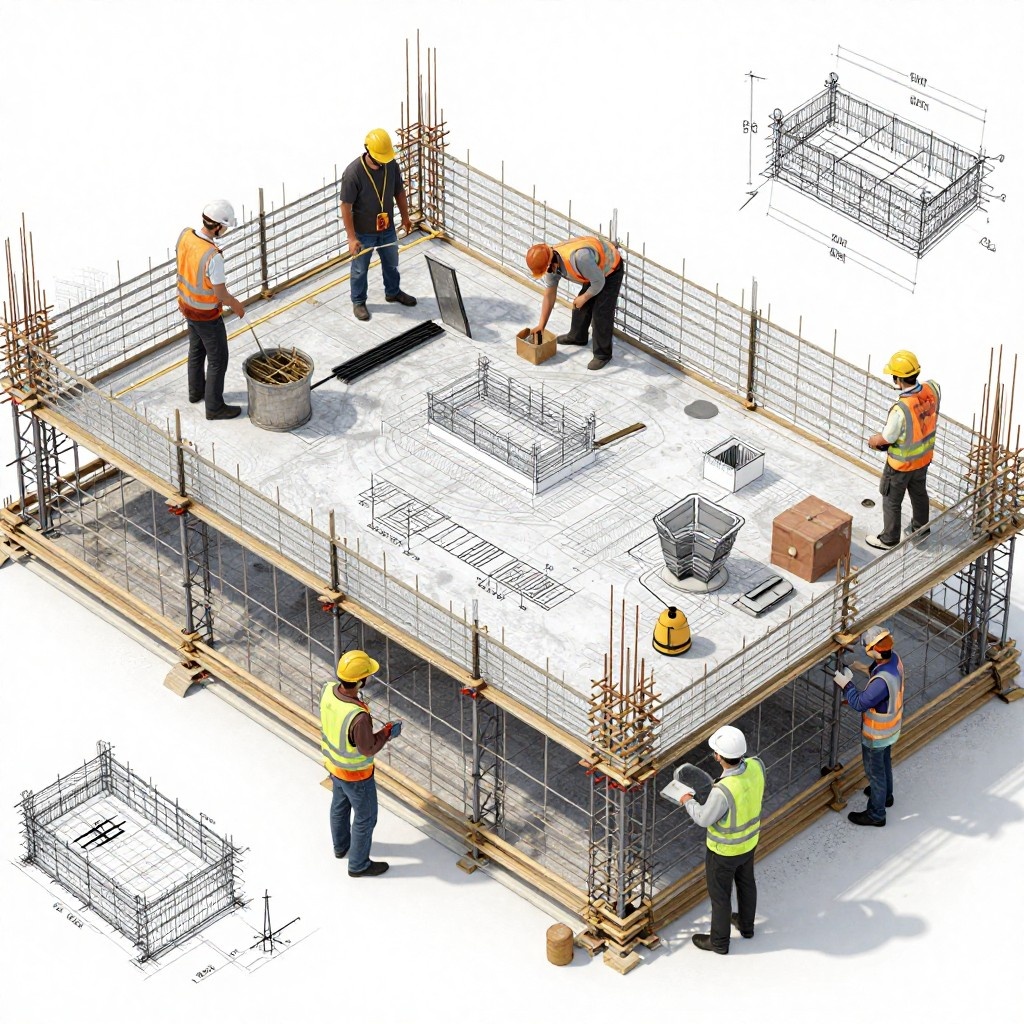Need for BIM Clash Detection
Clash detection stands as a bulwark against the cascading effects of design conflicts, preventing multi-level changes, budget overruns, and delays. Its integration into modern construction practices accelerates project timelines and fortifies against the domino effect of errors that could jeopardize project success. By identifying clashes early in the design phase, BIM clash detection mitigates risks, enhances project predictability, and safeguards against costly rework.
The Clash Detection Process
The clash detection process is a critical component of the BIM workflow, seamlessly integrating various professionals like architects, structural engineers, and MEP engineers. Traditionally, identifying clashes in construction projects was a cumbersome task, often left until the construction phase, leading to costly delays and rework. However, with the advent of BIM, clash detection has been revolutionized. In a Level 2 BIM process, multiple federated models are produced, allowing designers to check for clashes within their own models and during the coordination of combined models. This collaborative approach ensures that potential clashes are identified and resolved early in the design phase, minimizing the risk of conflicts during construction.

BIM modeling software and integration tools play a crucial role in facilitating clash detection. These tools enable designers to evaluate a large number of federated models simultaneously, making it easier to identify clashes across various disciplines. Moreover, clash detection software has become increasingly sophisticated, allowing users to check for clashes within specific subsets and flag them on-screen. This advanced functionality streamlines the coordination process, ensuring that all elements of the design work harmoniously together.
The integration of BIM has transformed the clash detection process, making it more efficient and effective. By detecting clashes during the earliest stages of design, architects and engineers can address potential conflicts before they escalate, preventing costly delays and design revisions later in the project lifecycle. With BIM, clash detection becomes a proactive endeavor rather than a reactive one, allowing project teams to identify and resolve issues in real-time, ultimately leading to smoother construction processes and superior project outcomes.
Tools like Autodesk Navisworks exemplify the power of BIM in clash detection. Navisworks allows users to upload and coordinate multiple design models, detecting clashes between different disciplines such as architecture, structure, and MEP. The software generates detailed clash reports, providing valuable insights into potential conflicts and enabling project teams to take proactive measures to resolve them. Additionally, Navisworks facilitates collaboration among project stakeholders, allowing for seamless communication and coordination throughout the clash detection process.
In conclusion, the clash detection process within the BIM framework represents a significant advancement in construction technology. By integrating various professionals and leveraging sophisticated modeling software, BIM enables project teams to identify and resolve clashes early in the design phase, mitigating the risk of costly delays and rework during construction. With tools like Autodesk Navisworks, clash detection becomes an integral part of the project workflow, fostering collaboration and efficiency among project stakeholders.



Types of Clashes in BIM
Clashes in BIM encompass various categories, each presenting unique challenges and implications. Detecting and resolving clashes in the virtual environment of BIM significantly reduces the likelihood of costly errors and rework during the construction phase.Let's delve into the intricacies of clashes in BIM and their various types:
1. Hard Clash:
Hard clashes, also known as geometric clashes, occur when there is a physical collision or interference between building elements or systems in a construction project. For instance, a hard clash could occur if a structural beam intersects with a duct or pipe, hindering the installation or functionality of one or both elements. Hard clashes are typically identified using clash detection software, which analyzes 3D models of building components to detect instances of collision or interference. Resolving hard clashes often involves making adjustments to the design, such as repositioning or resizing building components to eliminate the collision. Coordination between various stakeholders is essential to address hard clashes effectively and ensure that design modifications do not compromise project requirements.

2. Soft Clash:
Soft clashes, also known as non-geometric clashes, are conflicts that arise from sequencing, coordination, or other non-physical issues within a construction project. For example, a soft clash may occur if the installation sequence of MEP systems conflicts with the workflow of other trades, leading to inefficiencies or delays. Soft clashes are often identified through collaboration and communication among project stakeholders rather than through automated clash detection software. Resolving soft clashes requires effective project management and coordination to align schedules, workflows, and project requirements. Proactive communication and collaboration among contractors, subcontractors, and design teams are essential to address soft clashes and maintain project progress.

3. 4D Clash:
4D clashes involve clashes that occur as a result of scheduling or sequencing conflicts in a construction project's timeline, adding the dimension of time (4D) to clash detection and resolution. For instance, a 4D clash may occur if the installation of building components is scheduled to take place before the completion of structural modifications, leading to conflicts in the construction sequence. 4D clashes are identified by integrating project schedules or construction timelines with clash detection software or project management tools. Resolving 4D clashes requires adjusting construction schedules to ensure that conflicting activities are sequenced appropriately. By aligning construction activities with project milestones and dependencies, 4D clash resolution helps maintain project progress and minimize delays.

Utilizing advanced clash detection tools and methodologies, BIM facilitates proactive identification and resolution of clashes throughout the design and construction phases. By fostering collaboration and coordination among project stakeholders, clashes in BIM can be efficiently addressed, leading to smoother construction processes and superior project outcomes.
Benefits of Clash Detection
The implementation of BIM clash detection yields a plethora of benefits, revolutionizing project management practices. By identifying and resolving clashes before construction commences, project timelines are compressed, costs are minimized, and productivity is enhanced. Moreover, clash detection fosters collaboration, streamlines decision-making, and elevates project outcomes by ensuring adherence to design intent and regulatory standards.
Clash Detection Software and Tools
When it comes to ensuring smooth coordination and minimizing errors in construction projects, clash detection software plays a pivotal role. Among the top contenders in this domain are Navisworks and Autodesk BIM Collaborate. Navisworks stands out for its advanced clash detection capabilities and quantification tools, empowering users to validate and collaborate on proposed resolutions in a shared environment. These tools promote real-time collaboration, automate repetitive tasks, and optimize clash management workflows, enhancing overall project efficiency and quality.
- Navisworks:
- Advanced clash detection capabilities and quantification tools.
- Facilitates collaboration on proposed resolutions in a shared environment.
- Offers 4D and 5D simulation features for enhanced project scheduling and budgeting.
- Enables direct creation of schedules from models.
- Integrates with third-party project management applications for seamless coordination.

- Autodesk BIM Collaborate:
- Allows project members to upload models, detect clashes, and resolve issues in real time.
- Offers unlimited projects and file storage for enhanced flexibility.
- Provides mobile-friendly tools for viewing models from anywhere.
- Facilitates efficient decision-making and collaboration among stakeholders.
- Ensures secure storage and accessibility of project information.

- MagiCAD:
- MEP-specific add-in for AutoCAD and Revit.
- Offers clash detection functionality along with other modeling functions.
- Allows exporting clash reports via popular BCF file format.
- Enhances compatibility with many issue-tracking platforms.

- Solibri Model Checker:
- Offers powerful clash detection tools combined with compliance control and design review.
- Capable of spotting false-positive clashes and grouping clashes by specific parameters.
- Provides data checking for maintenance and other capabilities.

- Fuzor:
- Multifunctional platform offering clash detection and support for multiple file formats.
- Capable of checking for both hard and soft clashes.
- Provides clash reports and supports various file types outside Autodesk.

- Revizto:
- Integrated collaboration platform offering clash detection among other features.
- Known for accessibility and ease of use.
- Facilitates efficient collaboration and communication among project teams.

Future of BIM Clash Detection
As technology evolves, the landscape of BIM clash detection is poised for further innovation and refinement. The future holds promises of increased interoperability, real-time collaboration features, and enhanced clash management capabilities. Embracing these advancements will unlock new frontiers in project coordination, accelerating the transition towards seamless, data-driven construction processes.
Conclusion
In conclusion, mastering clash detection in BIM is pivotal for achieving efficiency and excellence in construction projects. By leveraging advanced software, embracing collaborative workflows, and staying abreast of emerging trends, project teams can navigate the complexities of clash detection with confidence. As clash detection evolves, it will continue to shape the future of construction, driving progress, and innovation across the industry.
FAQs
How do you check clashes in Revit?
In Revit, clashes can be checked using the built-in Clash Detection feature or by integrating with external clash detection software such as Navisworks. Users can run clash tests to identify conflicts between different building elements within their models and streamline the resolution process.
How do I check clashes on BIM 360?
BIM 360 offers clash detection capabilities through its coordination module, allowing users to detect clashes between multidisciplinary models in a cloud-based environment. By leveraging BIM 360's clash detection tools, project teams can collaborate effectively and resolve design conflicts efficiently.
What is clash detection in Navisworks?
Clash detection in Navisworks is a powerful feature that enables users to identify and resolve clashes between various building components across different disciplines. Navisworks facilitates clash detection by aggregating models from different sources and providing comprehensive visualization and analysis tools for clash resolution.In the realm of modern construction, where precision, efficiency, and cost-effectiveness reign supreme, mastering clash detection through BIM has emerged as a pivotal practice. Clash detection serves as a preemptive strike against potential design conflicts, paving the way for smoother project execution and enhanced collaboration among stakeholders. In this comprehensive guide, we delve into the depths of BIM clash detection, unraveling its significance, process, types, benefits, software, and future prospects.




